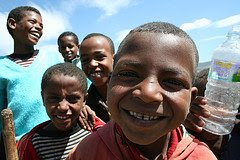 "Did you know that the National Audubon Society is for people as well as birds and wildlife? I didn't. Then one day last August I received an email about an Audubon-sponsored trip to Ethiopia." So starts a piece written by one of my compatriots on the Berga site visit last November.
"Did you know that the National Audubon Society is for people as well as birds and wildlife? I didn't. Then one day last August I received an email about an Audubon-sponsored trip to Ethiopia." So starts a piece written by one of my compatriots on the Berga site visit last November.Ruth Ann Wiesenthal-Gold, a volunteer with Audubon in Florida, captures the perspective of the conservationist coming to better understand Ethiopia's overlapping economic, environmental, social, and political challenges by seeing them first-hand. In her piece for Big Cat Rescue, she weaves in first person narrative with statistics about Ethiopia's challenging conditions, highlighting particularly the tough roles of women and girls. Ruth Ann has been a great supporter of my Losing Pounds for Berga effort, loyally reading this points and sending notes of encouragement. It is great she is sharing her insights from having visited the Berga Wetland site with other U.S.-based conservationists who as she says, need to come to understand as she did that people and their development conditions are a key part of their conservation organization's work.




